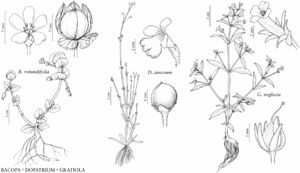Dopatrium junceum
Scroph. Ind., 31. 1835.
Annuals 10–30 cm. Leaves: basal and proximal 4–8, blade oblong, 10–25 × 2–10 mm, apex obtuse; distal blade linear-lanceolate, 2–7 × 0.5–2 mm. Inflorescences: proximal flowers sessile, cleistogamous, distal pedicellate, chasmogamous; proximal bracts leaflike, distal scalelike. Pedicels spreading in fruit, 4–11 mm, sparsely glandular. Flowers: calyx 1–2 mm, lobes equal, apex obtuse; corolla 4–7 mm, tube slightly longer than calyx, abaxial lip with middle lobe longer than lateral lobes, adaxial lip erect. Capsules 2 mm. Seeds 0.4–0.5 × 0.2 mm, testa netted. 2n = 14.
Phenology: Flowering Jun–Sep.
Habitat: Drying wetlands, rice fields, ditches.
Elevation: 0–200 m.
Distribution
Introduced; Calif., La., Asia, Africa, Australia
Discussion
First collected as a rice field weed in Butte County, California, in 1944 (C. V. Morton and J. T. Howell 1945), Dopatrium junceum has spread across similar habitats in the Sacramento Valley (S. C. H. Barrett and D. E. Seaman 1980) and in Louisiana (J. W. Thieret and D. H. Dike 1969). Dopatrium junceum germinates in inundated wetlands in May and blooms during summer, which suggests that, at least in California, it is unlikely to spread to vernal pools and other seasonal wetlands that are inundated only during the winter rainy season.
Selected References
None.
